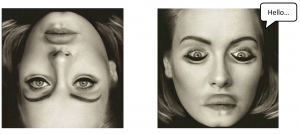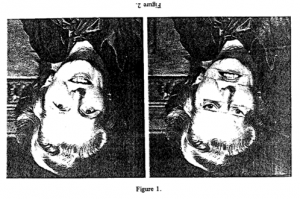Adele’s face is the latest victim of a viral illustration of perceptual illusions. During the past week, an image of Adele’s upside down-face has gone viral on the internet, with instructions that read “turn your phone upside down” or “look at the image upside down.” If you haven’t done the experiment yourself, it looks something like this. Both images are the same, but the message of the image is drastically different. In the left picture, Adele’s expression appears soft and gentle (alike the original image). However the right image looks somewhat angered and frightening. They are the same image though, so how is the orientation affecting the way we process this image?
In 1980, psychologist Peter Thompson wanted to learn more about how the human mind processed faces [1]. Psychologists before had noted how emotion was more difficult to read on faces when they were upside down, and that the eyes and mouth were the two features of the face that we use the most for emotional processing . Thus, Thompson flipped an image of Margaret Thatcher’s face, and flipped her eyes and mouth. What has since followed has been dubbed the “Thatcher” effect.
The Thatcher effect is characterized by an upside-down face looking quite normal, and then when viewed upside down, looks like some frankensteined version of an undead WOW character. In the case of Adele’s example, the two images are identical. So why doesn’t our brain realize that Adele’s face is terrifying before we go for the phone flip? It would have been nice to have some warning, don’t you think?
Our brains are masters at human face perception. In fact, we have an entire brain network comprised over 25 individual brain regions that help us to process human faces [2]. Researchers believe that part of this processing lies within a somewhat continuous search of patterns and ratios that make up the human face (two symmetrical circles for eyes a little bit apart, a dark brow-looking line right above those circles, etc.). This pattern recognition is so persistent that it can even lead to things like Pareidolia, where humans recognize faces in everyday objects like tacos or grill-cheese sandwiches [3].
More pertinent to the examples of Adele’s upside-down face, our brain has been thought to process faces at a more holistic level, processing the entire face rather than each feature of the face individually [4]. This allows us to instantly recognize a face and interpret specific things about it (angry face, sad face). But when that face is turned upside down, this process changes.
Humans (and even monkeys) are inherently worse at reading upside-down faces compared to faces that are right-side up [5]. This is likely because the change in directionality disrupts the patterns and ratios that make up any human face— a pattern we rely on to interpret faces. Further, our ability to process the face as a whole when we look at an upside-down face suffers, so we start to process individual features of the face more [6].
In the case of upside-down Adele, our brains switch from holistic to more individualistic processing. She looks fine this way because the ratio of her face is generally still the same, and her eyes are right-side up– the way we are used to seeing them! Same goes for the mouth, it is the same direction we are used to and our brain doesn’t think to tell us that a right-side up pair of eyes is wrong on an upside-down face. However when the image is flipped right-side up, our brains are now processing that face holistically again and we instantly recognize that everything is wrong and slightly terrifying.
Our brain has been tricked by this illusion, but it illustrates a pretty unique feature of the way we process human faces.
=) Pretty cool stuff.
References
[1] Thompson, P. (1980). Margaret Thatcher: a new illusion. Perception, 38, (6). 483-484.
[2] Zhen, Z., Fang, H., & Liu, J. (2013). The Hierarchical Brain Network for Face Recognition. Plos One, 8, 3. DOI: 10.1371/journal.pone.0059886
[3] Pareidolia: Why we see faces in hills, the Moon and toasties – BBC News. (2013, May 31). Retrieved March 07, 2016, from http://www.bbc.com/news/magazine-22686500
[4] Richler, J. J., Cheung, O. S., & Gauthier, I. (2011). Holistic Processing Predicts Face Recognition. Psychological Science, 22(4), 464–471. http://doi.org/10.1177/0956797611401753
[5] Adachi, I., Chou, D. P., & Hampton, R. R. (2009). Thatcher effect in monkeys demonstrates conservation of face perception across primates. Current Biology: CB, 19(15), 1270–1273. http://doi.org/10.1016/j.cub.2009.05.067
[6] C. (2006, September 23). Cool Visual Illusions: The Margaret Thatcher Illusion. Retrieved March 06, 2016, from http://scienceblogs.com/mixingmemory/2006/09/23/cool-visual-illusions-the-marg/

